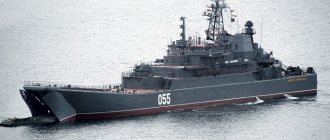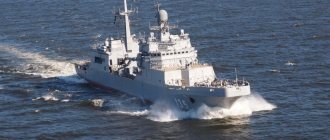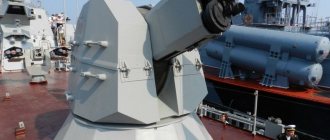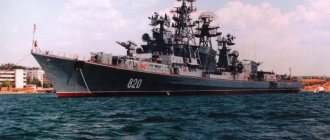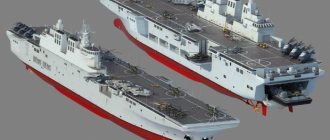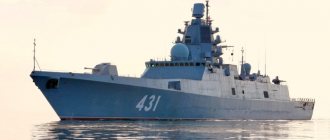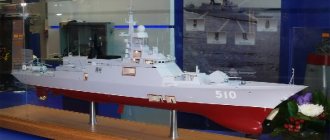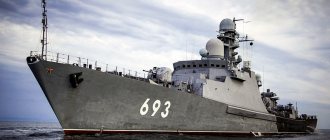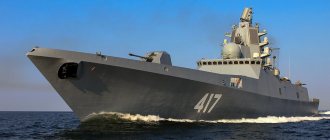Large landing ships of Project 775 (NATO codification - Ropucha (toad in Polish)) are a series of large landing ships, the construction of which was carried out in the Polish People's Republic, in Gdansk, by order of the Navy. Ships are necessary for transporting cargo and troops, as well as for amphibious landings on unequipped coasts. The capabilities also include transportation of various types of armored vehicles. They are assigned a leading role in the landing fleet of the Russian Federation. Until 1977, according to the classification, they belonged to medium landing ships. In the future, it was planned to replace them with the Project 778 BDK, the construction of which was also expected in Gdansk. But in 1992, two unfinished ships of this project were cut up on the stocks.
Photos
Story
3.1 Development history
The Navy needed to replace the aging large landing ships of Project 1171, created on the basis of a dry cargo ship. Their successors had to be designed specifically for landing operations, have greater survivability and weapons power. The new ships were supposed to stand in importance between the Project 1174 BDK (Rhinoceros) and medium landing ships. Design of the 775 was carried out in the Polish People's Republic.
3.2 Service history
The BDK of this project has repeatedly participated in various operations, without loss. These include, for example:
- Evacuation of Soviet citizens from the port of Aden during the Aden Civil War in 1986.
- Evacuation from Nokra Island (Eritrea, then Ethiopia) in 1991.
- Functioning as dry cargo ships to support naval units in Sakhalin, Kamchatka and the Kuril Islands.
- Participation in an international campaign to provide assistance to foreign countries in war zones in the Indian Ocean.
- Delivery of goods to the Syrian government from April 2014 to the present (as part of the Syrian Express campaign).
In the spring of 2014, the crew of one of the ships of this project, Konstantin Olshansky, a large landing craft of the Ukrainian Navy, raised the St. Andrew's flag. As of August 2014, this ship is part of the 197th brigade of landing ships of the Russian Black Sea Fleet.
Composition of the series
The construction of large landing ships of Project 775 took place from 1974 to 1985. The construction of the lead ship "SDK-47" (serial number - 1) was carried out in 1974 in the Polish People's Republic. A total of 25 ships were built in this project, and 3 ships in project 775M (with modernized weapons). One of the 775 ships was exported to Yemen in 1979.
Project 775:
- SDK-47 (BDK-47); Board number - 134; Serial number - 775/1; Put into operation - 07/01/1974; Fleet - BF
- SDK-48 (BDK-48); Board number - 061; Serial number - 775/2; Put into operation - 06/30/1975; Fleet - Pacific Fleet
- SDK-63 (BDK-63); Board number - 083; Serial number - 775/3; Put into operation - 06/30/1975; Fleet - Pacific Fleet
- SDK-90 (BDK-90); Board number - 058; Serial number - 775/4; Put into operation - November 30, 1975; Fleet-Pacific Fleet
- SDK-91 (BDK-91), “Olenegorsky miner”; Board number - 012; Serial number - 775/5; Put into operation - 06/30/1976; Fleet - SF
- SDK-181 (BDK-181); Board number - 083; Serial number - 775/6; Put into operation - 10/09/1976; Fleet - Pacific Fleet
- SDK-182 (BDK-182), "Kondopoga"; Board number - 027; Serial number - 775/7; Put into operation - November 30, 1976; Fleet - SF
- SDK-183 (BDK-183), "Kotlas"; Board number – 035; Serial number - 775/8; Put into operation - 03/15/1977; Northern Fleet
- SDK-197 (BDK-197); Board number – 055; Serial number - 775/9; Put into operation - 09/21/1977; Fleet - Pacific Fleet
- SDK-200 (BDK-200); Board number – 011; Serial number - 775/10; Put into operation – 1977; Fleet - SF
- SDK-55 (BDK-55), "Alexander Otrakovsky"; Board number - 031; Serial number - 775/11; Put into operation - 07/30/1978; Fleet - SF
- SDK-119 (BDK-119); Board number - n/a; Serial number - 775/12; Put into operation - 02/27/1979; Fleet - Pacific Fleet, Yemeni Navy.
Project 775/II:
- BDK-14; Board number – 070; Serial number - 775/13; Put into operation - 08/31/1981; Fleet - Pacific Fleet
- BDK-101, "Oslyabya"; Board number – 066; Serial number - 775/14; Put into operation - 12/19/1981; Fleet - Pacific Fleet
- BDK-105; Board number – 125; Serial number - 775/15; Put into operation - 03/02/1982; Fleet - BF
- BDK-98, "Admiral Nevelskoy"; Board number – 055; Serial number - 775/16; Put into operation - 09/28/1982; Fleet - Pacific Fleet
- BDK-32; Board number – 039; Serial number - 775/17; Put into operation – 1982; Fleet - SF
- BDK-43, "Minsk"; Board number – 127; Serial number - 775/18; Put into operation - 05/30/1983; Fleet - BF
- BDK-58, "Kaliningrad"; Board number – 102; Serial number - 775/19; Put into operation - 12/09/1984; Fleet - BF
- BDK-45, "St. George the Victorious"; Board number – 016; Serial number - 775/20; Put into operation - 03/05/1985; Fleet - SF
- BDK-56, “Konstantin Olshansky”, Board number – 402; Serial number - 775/21; Put into operation – 1985; Fleet - Black Sea Fleet
- BDK-60, "Alexander Shabalin"; Board number – 110; Serial number - 775/22; Put into operation - 12/31/1985; Fleet - BF
- BDK-64, "Caesar Kunikov"; Board number – 158; Serial number - 775/23; Put into operation - 09/30/1986; Fleet - Black Sea Fleet
- BDK-46, Novocherkassk; Board number – 142; Serial number - 775/24; Put into operation - November 30, 1987; Fleet - Black Sea Fleet
- BDK-67, "Yamal"; Board number – 156; Serial number - 775/25; Put into operation - 04/30/1988; Fleet - Black Sea Fleet.
Project 775/III:
- BDK-54, "Azov"; Board number – 151; Serial number - 775/26; Put into operation - 10/12/1990; Fleet - Black Sea Fleet
- BDK-11, "Peresvet"; Board number – 077; Serial number - 775/27; Put into operation - 04/10/1991; Fleet - Pacific Fleet
- BDK-61, "Korolev"; Board number – 130; Serial number - 775/28; Put into operation - 07/10/1991; Fleet - BF.
Tactical and Technical Characteristics
5.1 Main characteristics
- Displacement: 2900 t (light), 3450 t (normal), 4400 t (full)
- Length: 112.5 m (longest)
- Width: 15 m (largest)
- Draft: 3.7 m (at full displacement)
- Engines: 2 diesel engines, 3 × diesel generators, 16 ZVB 40/48
- Power: 2 × 9600 l. s., 3 × 750 kW
- Propulsion: 2 × stern retractable propellers, 2 × fixed propellers
- Speed: 17.5 knots (full)
- Cruising range: 3500 miles (at 16 knots), 6000 miles (at 12 knots)
- Sailing autonomy: 30 days
- Crew: 87 people (8 officers).
5.2 Armament
- Navigation weapons: "Don" or "Mius" or "Vaigach" or "Nayada" navigation radars
- Radar weapons: RLSO NTs and VTs MR-302 “Rubka” (project 775/II) or
- MR-352 “Positive” (project 775/III), two MR-212/201 radars
- Electronic weapons: MR-103 “Bars” or MR-123/176 “Vympel” fire control system (Project 775/III), PS-73 “Groza” control system, 2 × 82 mm launchers of the PK-16 complex and MP-405 electronic warfare system "Start" (project 775/III)
- Artillery: 2 × AK-725 or 1 × AK-176 (Project 775/III)
- Anti-aircraft artillery: 2 × AK-630M (Project 775/III)
- Missile weapons: 2 × A-215 "Grad-M" (total - 320 NURS), 2 × MANPADS "Strela-3" or "Igla".
5.3 Landing capabilities
Project 775 BDKs are capable of transporting 10 tanks and 225 paratroopers or a reinforced company of marines. The weight of the cargo compartment is up to 480 tons, its dimensions are 95 × 4.5 × 4.5 m. Accommodation for paratroopers is located in 4-berth officer cabins and cockpits.
Large landing ship "Minsk" project 775/II
The large landing ship Minsk is the sixth in a series of 13 Project 775/II ships, which is the second series of Project 775 ships.
The ship is designed for amphibious landings on an unequipped coast and for transporting troops and cargo by sea. Capable of transporting various types of armored vehicles, including tanks.
Home base: Baltic Fleet.
Construction, name: The ship was built in Gdansk (Poland) in 1984. Initially it had the name "BDK-43".
Performance characteristics:
- Speed: 18 knots;
- Cruising range: 6000 miles at 12 knots;
- Crew: 87 people.
Dimensions:
- Displacement: 4080 tons;
- Length: 112.5 meters;
- Width: 15 meters;
- Draft: 3.7 meters.
Power plant: 2 diesel engines, 2 propellers, power - 19200 hp.
Armament: 2 twin 57 mm AK-725 artillery mounts, 2 launchers of the A-215 Grad-M multiple launch rocket system, 4 launchers of the Strela-2 man-portable anti-aircraft missile system. On board can be located up to 500 tons of equipment and cargo and 225 paratroopers.
On September 16, 2000, it was renamed “Minsk”.
In 2004, he made an unofficial visit to the British port of Plymouth.
In April 2005, he made a three-day “Memory Walk” to the places of military glory of the Great Patriotic War. On August 4, a skinhead sailor with a swastika tattoo on his shoulder was beaten on board a ship. On July 31, he took part in the naval parade in St. Petersburg on the occasion of Navy Day.
In the summer of 2011, he participated in the international exercises Baltops and Passex.
In September 2013, he began to carry out tasks according to the plans of the operational command in the Mediterranean.
According to a message dated May 15, 2014, he returned to the Military Harbor of the city of Baltiysk after completing the tasks of a long-distance sea voyage as part of the Mediterranean group of the Russian Navy.
On July 26, 2015, he took part in the naval parade on Navy Day in St. Petersburg. As part of the final inspection for the 2015 academic year, he took part in a planned exercise for the transfer by sea and landing of marine units of the coastal forces of the fleet on an unequipped coast, which took place in October. On November 11, 2015, I went on a long trip to the Mediterranean Sea. On February 19, 2016, it passed through the Bosphorus Strait and entered the Black Sea. According to a message dated September 08, 2016, he was accompanied in the English Channel by the patrol ship HMS Tyne (P281) of the Royal Navy. On September 09, it arrives at its permanent base in the port of Baltiysk.
In 2022, he took part in the naval parade in St. Petersburg. On October 4, he set out on a long voyage from the Baltic naval base. On April 16, 2022, made a business call to the Portuguese port of Lisbon. According to a message dated April 19, he went to sea to make the transition to his permanent base - in Baltiysk. On April 29, he returned from a long trip to Baltiysk. After this, he moved to Kronstadt to undergo maintenance and repair work, which will last until mid-July. On July 29, he will take part in the solemn naval parade on the occasion of Russian Navy Day, and then return to his home base.
According to a message dated November 30, 2022, he arrived at his permanent base after completing combat training missions in the Baltic Sea.
According to a message dated February 26, 2022, he is practicing elements of the second course task (K-2) at sea. According to a message dated May 05, he returned home after a 20-day deployment in the Baltic Sea. According to a message dated August 7, as part of the Russian Navy exercise “Ocean Shield - 2019”, it successfully completed tasks to repel attacks by air attack weapons of a mock enemy.
